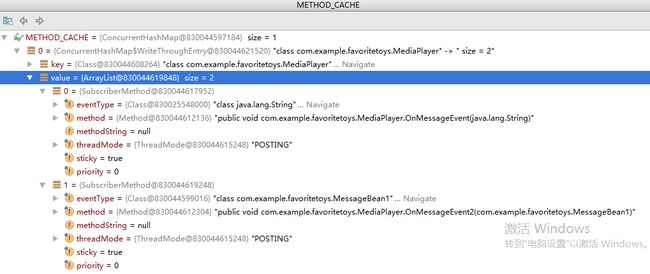从过去一直到现在,常用到的几种通信方式:
Handler;
自定义回调接口;
使用广播;
-
EventBus进行应用内通信;
EventBus in 3 steps:
1.从它的注册开始:EventBus.getDefault().register(this);
EventBus.getDefault()在源码里的实现如下:
/** Convenience singleton for apps using a process-wide EventBus instance. */
public static EventBus getDefault() {
if (defaultInstance == null) {
synchronized (EventBus.class) {
if (defaultInstance == null) {
defaultInstance = new EventBus();
}
}
}
return defaultInstance;
}
获取实例的时候使用的是单例模式。
register()方法:
/**
* Registers the given subscriber to receive events. Subscribers must call {@link #unregister(Object)} once they
* are no longer interested in receiving events.
*
* Subscribers have event handling methods that must be annotated by {@link Subscribe}.
* The {@link Subscribe} annotation also allows configuration like {@link
* ThreadMode} and priority.
*/
public void register(Object subscriber) {
//获取当前类的字节码
Class subscriberClass = subscriber.getClass();
//它会查找在当前类里含有注解Subscriber的public的event方法,通俗的说就是查看这个订阅者订阅了哪些事件,因为可能有多个事件,所以是集合。
List subscriberMethods = subscriberMethodFinder.findSubscriberMethods(subscriberClass);
synchronized (this) {
//循环遍历集合,将订阅者和这些事件subscribe起来,订阅事件
for (SubscriberMethod subscriberMethod : subscriberMethods) {
//遍历所有的方法,依次完成订阅者对方法的订阅
subscribe(subscriber, subscriberMethod);
}
}
}
注释中说明:注册订阅者去接受事件,订阅者在它们一旦不想接受事件的时候必须调用unregister(object)方法。
订阅者处理事件的方法必须使用注解:Subscribe.
这个Subscribe同时也允许配置像 ThreadMode 一样还有优先级。
其中:subscriberMethodFinder 是用来查找订阅者订阅了哪些事件的类。
SubscriberMethod 对象是 订阅方法的对象,包括优先级啊,是否是黏性啊等,类部分源码如下:
public class SubscriberMethod {
//订阅的方法
final Method method;
//线程
final ThreadMode threadMode;
//事件类型
final Class eventType;
//优先级
final int priority;
//是否黏性
final boolean sticky;
/** Used for efficient comparison */
String methodString;
public SubscriberMethod(Method method, Class eventType, ThreadMode threadMode, int priority, boolean sticky) {
this.method = method;
this.threadMode = threadMode;
this.eventType = eventType;
this.priority = priority;
this.sticky = sticky;
例如:我们订阅的一个类的方法如下:
public class MediaPlayer {
public MediaPlayer(){
EventBus.getDefault().register(this);
}
@Subscribe(sticky = true)
public void OnMessageEvent(String message){
Log.d("xx","message::"+message);
EventBus.getDefault().removeStickyEvent(this);
}
@Subscribe(sticky = true)
public void OnMessageEvent2(MessageBean1 message){
Log.d("xx","message::"+message.getMessage());
EventBus.getDefault().removeStickyEvent(this);
}
}
那么我们对应SubscriberMethod的值就为:
然后我们看下这个findSubscriberMethods方法,是如何查找的:
List findSubscriberMethods(Class subscriberClass) {
List subscriberMethods = METHOD_CACHE.get(subscriberClass);
//如果缓存map里有,直接取出
if (subscriberMethods != null) {
return subscriberMethods;
}
//是否忽略注解器生成的index类,默认为false
if (ignoreGeneratedIndex) {
subscriberMethods = findUsingReflection(subscriberClass);
} else {
//通过反射找到注解方法
subscriberMethods = findUsingInfo(subscriberClass);
}
if (subscriberMethods.isEmpty()) {
throw new EventBusException("Subscriber " + subscriberClass
+ " and its super classes have no public methods with the @Subscribe annotation");
} else {
METHOD_CACHE.put(subscriberClass, subscriberMethods);
return subscriberMethods;
}
}
其中这个 METHOD_CACHE是缓存订阅者的方法的,key是订阅者,value 是订阅者订阅的事件,还是拿我上面那个MediaPlayer类举例,如图所示:
这个无论是findUsingRefection还是findUsingInfo都会调用findUsingReflectionInSingleClass(findState);这个方法:
private void findUsingReflectionInSingleClass(FindState findState) {
Method[] methods;
try {
// This is faster than getMethods, especially when subscribers are fat classes like Activities
methods = findState.clazz.getDeclaredMethods();
} catch (Throwable th) {
// Workaround for java.lang.NoClassDefFoundError, see https://github.com/greenrobot/EventBus/issues/149
methods = findState.clazz.getMethods();
findState.skipSuperClasses = true;
}
for (Method method : methods) {
int modifiers = method.getModifiers();
if ((modifiers & Modifier.PUBLIC) != 0 && (modifiers & MODIFIERS_IGNORE) == 0) {
Class[] parameterTypes = method.getParameterTypes();
if (parameterTypes.length == 1) {
Subscribe subscribeAnnotation = method.getAnnotation(Subscribe.class);
if (subscribeAnnotation != null) {
Class eventType = parameterTypes[0];
if (findState.checkAdd(method, eventType)) {
ThreadMode threadMode = subscribeAnnotation.threadMode();
findState.subscriberMethods.add(new SubscriberMethod(method, eventType, threadMode,
subscribeAnnotation.priority(), subscribeAnnotation.sticky()));
}
}
} else if (strictMethodVerification && method.isAnnotationPresent(Subscribe.class)) {
String methodName = method.getDeclaringClass().getName() + "." + method.getName();
throw new EventBusException("@Subscribe method " + methodName +
"must have exactly 1 parameter but has " + parameterTypes.length);
}
} else if (strictMethodVerification && method.isAnnotationPresent(Subscribe.class)) {
String methodName = method.getDeclaringClass().getName() + "." + method.getName();
throw new EventBusException(methodName +
" is a illegal @Subscribe method: must be public, non-static, and non-abstract");
}
}
}
通过这个代码我们可以看出来,就是通过反射得到所有的方法,然后再通过是否标识注解,最终保存到
findState.subscriberMethods.add(new SubscriberMethod(method, eventType, threadMode,
subscribeAnnotation.priority(), subscribeAnnotation.sticky()));```
需要注意的是,如果注解方法中传的参数不是一个,就会抛出`must have exactly 1 parameter`异常;还有就是如果被注解的方法不是public,也会抛出`
is a illegal @Subscribe method: must be public...`的异常。
接下来,我们重点看下`subscribe(subscriber, subscriberMethod);`的实现:
// Must be called in synchronized block
private void subscribe(Object subscriber, SubscriberMethod subscriberMethod) {
//获取订阅方法的事件类型
Class eventType = subscriberMethod.eventType;
//将这个订阅者还有订阅的事件封装到一个Subscription的对象中
Subscription newSubscription = new Subscription(subscriber, subscriberMethod);
//根据订阅者得到订阅者订阅方法一些信息,包括级别,线程等,可参考下图
CopyOnWriteArrayList subscriptions = subscriptionsByEventType.get(eventType);
if (subscriptions == null) {
subscriptions = new CopyOnWriteArrayList<>();
subscriptionsByEventType.put(eventType, subscriptions);
} else {
//如果不为null,看是否定义相同的方法
if (subscriptions.contains(newSubscription)) {
throw new EventBusException("Subscriber " + subscriber.getClass() + " already registered to event "
+ eventType);
}
}
//而后根据优先级添加到subscriptions
int size = subscriptions.size();
for (int i = 0; i <= size; i++) {
if (i == size || subscriberMethod.priority > subscriptions.get(i).subscriberMethod.priority) {
subscriptions.add(i, newSubscription);
break;
}
}
//这个`typesBySubscriber` 是
Map>> typesBySubscriber,key 是订阅者,value 是订阅的方法。
值得话还是看下图3更清晰直白一些;根据订阅者获取订阅的方法集合。
List> subscribedEvents = typesBySubscriber.get(subscriber);
if (subscribedEvents == null) {
subscribedEvents = new ArrayList<>();
typesBySubscriber.put(subscriber, subscribedEvents);
}
//如果不为null 将订阅的方法添加到`subscribedEvents`集合中
subscribedEvents.add(eventType);
//判断订阅的事件是否是黏性的
if (subscriberMethod.sticky) {
//eventInheritance 是否分发事件
if (eventInheritance) {
// Existing sticky events of all subclasses of eventType have to be considered.
// Note: Iterating over all events may be inefficient with lots of sticky events,
// thus data structure should be changed to allow a more efficient lookup
// (e.g. an additional map storing sub classes of super classes: Class -> List).
Set, Object>> entries = stickyEvents.entrySet();
for (Map.Entry, Object> entry : entries) {
Class candidateEventType = entry.getKey();
if (eventType.isAssignableFrom(candidateEventType)) {
Object stickyEvent = entry.getValue();
//最后都调用这个方法
checkPostStickyEventToSubscription(newSubscription, stickyEvent);
}
}
} else {
////最后都调用这个方法`checkPostStickyEventToSubscription`中就是立刻通知订阅者调用的订阅事件的方法。
Object stickyEvent = stickyEvents.get(eventType);
checkPostStickyEventToSubscription(newSubscription, stickyEvent);
}
}
}
上述CopyOnWriteArrayList的值
图3:
我们看下这个
checkPostStickyEventToSubscription方法:
private void checkPostStickyEventToSubscription(Subscription newSubscription, Object stickyEvent) {
if (stickyEvent != null) {
// If the subscriber is trying to abort the event, it will fail (event is not tracked in posting state)
// --> Strange corner case, which we don't take care of here.
postToSubscription(newSubscription, stickyEvent, Looper.getMainLooper() == Looper.myLooper());
}
}
然后就直接invoke 订阅者订阅的事件:
private void postToSubscription(Subscription subscription, Object event, boolean isMainThread) {
switch (subscription.subscriberMethod.threadMode) {
case POSTING:
invokeSubscriber(subscription, event);
break;
case MAIN:
if (isMainThread) {
invokeSubscriber(subscription, event);
} else {
mainThreadPoster.enqueue(subscription, event);
}
break;
case BACKGROUND:
if (isMainThread) {
backgroundPoster.enqueue(subscription, event);
} else {
invokeSubscriber(subscription, event);
}
break;
case ASYNC:
asyncPoster.enqueue(subscription, event);
break;
default:
throw new IllegalStateException("Unknown thread mode: " + subscription.subscriberMethod.threadMode);
}
}
Eventbus大概就是这样的,花了一天的时间。



